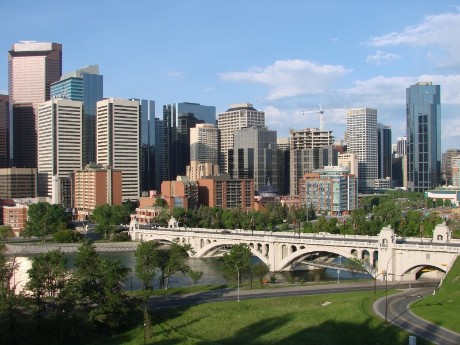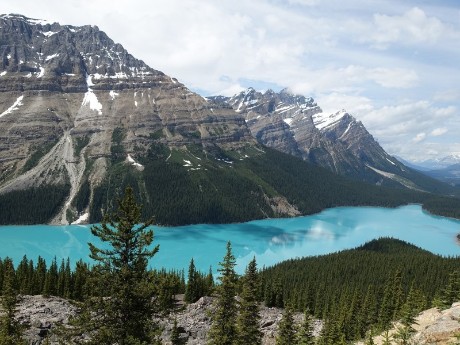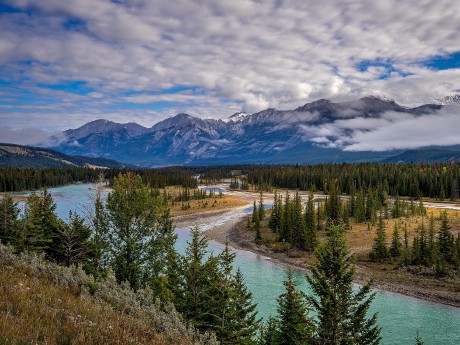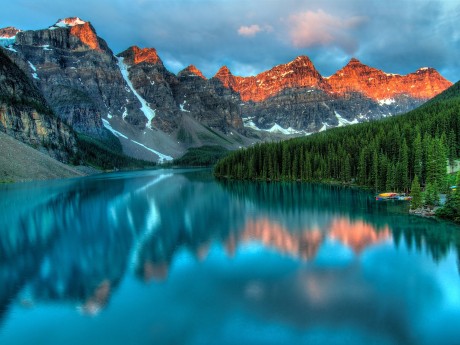Canadian Rockies Alberta: Adventure and Wellness
Your tour will start in Calgary where you can explore the city and take a canyoning tour to Drumheller, where you can visit the world famous Dinosaur Museum and the Atlas Coal Mine. The trip will continue to Banff, where the majestic Rockies await. The sweeping scenes of six mountain ranges, the Bow Valley and the charming town of Banff from the Sulphur Mountain summit will blow you away.
Read more
Your tour will start in Calgary where you can explore the city and take a canyoning tour to Drumheller, where you can visit the world famous Dinosaur Museum and the Atlas Coal Mine. The trip will continue to Banff, where the majestic Rockies await. The sweeping scenes of six mountain ranges, the Bow Valley and the charming town of Banff from the Sulphur Mountain summit will blow you away. There are many hiking trails but if you are not a hiker, the Banff Gondola will take you up and down the mountains with spectacular views. The Banff and Yoho National Parks have a lot to discover including historical cave sites, rivers, lakes and wildlife. After a long day of discovery or hiking, you can relax in the Natural Hot Water Springs or relax in one of the many spas in the area. Your trip concludes in the beautiful town of Jasper. Take a scenic tour of the Maligne Valley and Jasper’s National Park, the most beautiful areas. Stop at Maligne Canyon to see thundering waterfalls and continue to mysterious Medicine Lake, while exploring the valley in search of wild life. Waterviews strives to offer accommodation options within walking distance of water and/or in an area of touristic interest. Our prices include taxes (but excludes local tourist taxes). Customize your trip to your personal preferences with optional activities (hit the “Add Activities’’) or change hotels, etc. Contact us for customization at no extra cost at: Service@waterviewstravel.com
Destinations
- Calgary
- Banff
- Jasper
Itinerary
Calgary

The proud and cosmopolitan city of Calgary is situated at the confluence of the Bow and Elbow Rivers, and its proximity to stunning foothills and prairies as well as the Canadian Rocky Mountains alone make this city a must visit. Yet Calgary has more to offer than just nature, as the city has a growing craft bar and cafe scene, excellent restaurants and entertainment options as well as green parks and a pretty riverside perfect for exploring. Make sure to visit in July for the city’s famous cowboy festival, the Calgary Stampede.
Read more
The proud and cosmopolitan city of Calgary is situated at the confluence of the Bow and Elbow Rivers, and its proximity to stunning foothills and prairies as well as the Canadian Rocky Mountains alone make this city a must visit. Yet Calgary has more to offer than just nature, as the city has a growing craft bar and cafe scene, excellent restaurants and entertainment options as well as green parks and a pretty riverside perfect for exploring. Make sure to visit in July for the city’s famous cowboy festival, the Calgary Stampede.
Additional Information
History
Calgary was founded as Fort Brisebois by the Northwest Mounted Police (NWMP) in 1875. (The name was changed to Fort Calgary in 1876, named after Calgary Bay on the Isle of Mull.) The NWMP was sent west to ensure that Canada would not have an American-style "Wild West". Grave concerns about this were raised after the Cypress Hills Massacre of natives by drunken wolf hunters in 1873. Calgary was one of several forts established in Western Canada by the NWMP to ensure a police presence before the arrival of settlers.
In 1883, the railway reached Calgary. It started to grow in every direction and became an agricultural and business hub. In 1884, Calgary was incorporated as a town in what was then the North West Territories. By 1894, Calgary's population had grown to 3900 people and it was incorporated as a city.
Alberta's first major oil and natural gas field was discovered in 1914 at Turner Valley, 60 km south of Calgary. Subsequent discoveries kept the oil and gas scene active in the Turner Valley area for the next 30 years. When the Turner Valley fields were depleted, the next major oil and gas find was at Leduc (near Edmonton) in 1947. By then, Calgary was already established as a centre of oil and gas business.
During the 1950s, oil became big in Calgary and major American oil companies started heading to Calgary and opening offices. The boom extended into the next twenty years, bringing the city to 720,000 people in the metro area by 1985. The relatively low-key low-rise downtown became filled with a sea of skyscrapers, starting with the Calgary Tower and some other towers in the 1960s. By the 1980s, Calgary's luck turned, and a drop in oil prices sent the Calgary metro economy downward. Unemployment raged, vacancies surged, and growth was slow or even negative in some years.
In 1988, Calgary hosted the Winter Olympics and brought world attention to Calgary. By the 1990s, it was on the rebound and began growing again. Calgary today has become a more cosmopolitan city of over one million inhabitants with genuine attempts to diversify its economy and expand its attractiveness to outside visitors.
Onward!, the official motto of the city, was never more apt than in the wake of the major flooding the city experienced in June 2013. A year later, the casual visitor would have been hard-pressed to find any traces of the flood.
Climate
Calgary is sunny and rather dry, with wide seasonal and daily temperature ranges. Summers tend to be sunny and mild, highs averaging about in July/August, usually accompanied by short afternoon storms. June is normally the wettest month, although the Stampede in July is notorious for at least a few heavy showers, so be prepared if you plan to visit during this time. Hot weather greater than is rare, occurring on average five times a year. Also, temperatures typically drop dramatically on wet days as well; there's always a couple days in the summer months that barely manage highs over .
Winter can also vary quite a bit. Temperatures can get extremely cold, below , at times between November and March, while is possible (on average five times a year). Though average highs in January are about based on a current 30-year average, there's nothing average with Calgary's weather. Because of the regular but unpredictable chinooks (warm Pacific winds), there's no guarantee of when the cold weather may strike. One of the coldest months in the last ten years was a March (about for average high), while one January was very mild, average high. Temperatures can swell into the range one day, and drop back into the sub-zero (sub 32°F) range several days later. A typical chinook rolls in fast and is very windy. The warming effects will usually linger for several days to more than a week. In strong chinooks, you can see a chinook arch to the west: an arch of cloud with clear sky below. Calgary can be very dry in winter, with humidity as low as 20%, causing dry skin and making it challenging for contact lens wearers.
Regardless of the time of year, temperatures usually drop quickly at night. Lows in summer hover around , while in winter they average about . Because of the higher elevation and dramatic temperature drops, snow can fall as late as June and as early as September. These unseasonable snowfalls usually result in chaos in the city, as they tend to be heavy and wet, with fallen trees being a major threat. Calgary's weather can be quite unpredictable and can vary dramatically from year-to-year. Check the forecast ahead of time, because it will usually give you a good idea of what you will need to prepare for.
First-time visitors to Calgary should be careful to bring sunglasses (even in winter) as Calgary is the sunniest city in Canada, and the sun can make things quite hard on your eyes, especially in the winter as it reflects off of the snow.
© Sourced from Wikivoyage
Banff

The resort town of Banff is situated in its namesake park, the oldest in Canada, surrounded by the towering peaks of the Rocky Mountains. Its enchanting and scenic landscape is home to wildlife such as moose, mountain goats, brown and black bears, lynx, wolves and coyotes. Having emerged as a tourist destination, Banff seduces visitors with its unique atmosphere and is perfect for shopping, wandering through art exhibitions and eating in first-class restaurants.
Read more
The resort town of Banff is situated in its namesake park, the oldest in Canada, surrounded by the towering peaks of the Rocky Mountains. Its enchanting and scenic landscape is home to wildlife such as moose, mountain goats, brown and black bears, lynx, wolves and coyotes. Having emerged as a tourist destination, Banff seduces visitors with its unique atmosphere and is perfect for shopping, wandering through art exhibitions and eating in first-class restaurants.
Additional Information
Banff is a tourist town full of visitors and seasonal workers from across Canada and around the world. It is a convenient base for seeing some spectacular scenery with little effort. However, with convenience comes crowds. Banff Avenue can be very busy on summer afternoons and evenings, but it is a great place to stay for any length of time. There are a wide variety of restaurants and clubs and plenty of tours and activities to keep you busy. Staying in Banff during the winter gives easy access to the nearby ski areas of Norquay, Sunshine Village, and Lake Louise.
The area was named Banff in 1884 by George Stephen, president of the Canadian Pacific Railway, recalling his birthplace in Banff, Scotland.
Climate
At an elevation of 1400m above sea level and surrounded by mountains, the climate is subarctic. Banff has experienced snowfall even during the summer months. With daily mean temperatures of +15°C in the summer and -8°C in the winter, the climate is very similar to northern Scandinavia.
© Sourced from Wikivoyage
Jasper

Jasper National Park is a destination not to be missed when visiting Western Canada. With a landscape boasting crystal-clear lakes, majestic mountain peaks, glaciers and luscious forests, Jasper is a great alternative to the often more crowded Banff, with its breathtaking scenery in the Canadian Rockies even earning it a place as a UNESCO site. Enjoy hikes in the wilderness and soak up its natural beauty.
Read more
Jasper National Park is a destination not to be missed when visiting Western Canada. With a landscape boasting crystal-clear lakes, majestic mountain peaks, glaciers and luscious forests, Jasper is a great alternative to the often more crowded Banff, with its breathtaking scenery in the Canadian Rockies even earning it a place as a UNESCO site. Enjoy hikes in the wilderness and soak up its natural beauty.
Additional Information
History
Jasper House was a North West Company fur trade outpost established in 1813 on the York Factory Express trade route to what was then called "New Caledonia" (now British Columbia), and Fort Vancouver in Columbia District on the lower Columbia River. It was later taken oven by the Hudson's Bay Company.
Jasper National Park was established in 1907. The railway siding at the location of the future townsite was established by Grand Trunk Pacific Railway in 1911 and called named Fitzhugh after a Grand Trunk vice president[9](along the Grand Trunk's "alphabet" line). The Canadian Northern Railway began service to Fitzhugh in 1912. The townsite was surveyed in 1913 by H. Matheson. It was renamed Jasper after the former fur trade post. An internment camp was set up at Dominion Park in Jasper from February 1916 to August 1916.
By 1931, Jasper was accessible by road from Edmonton, and in 1940 the scenic Icefields Parkway opened, connecting Lake Louise and Jasper
© Sourced from Wikivoyage





